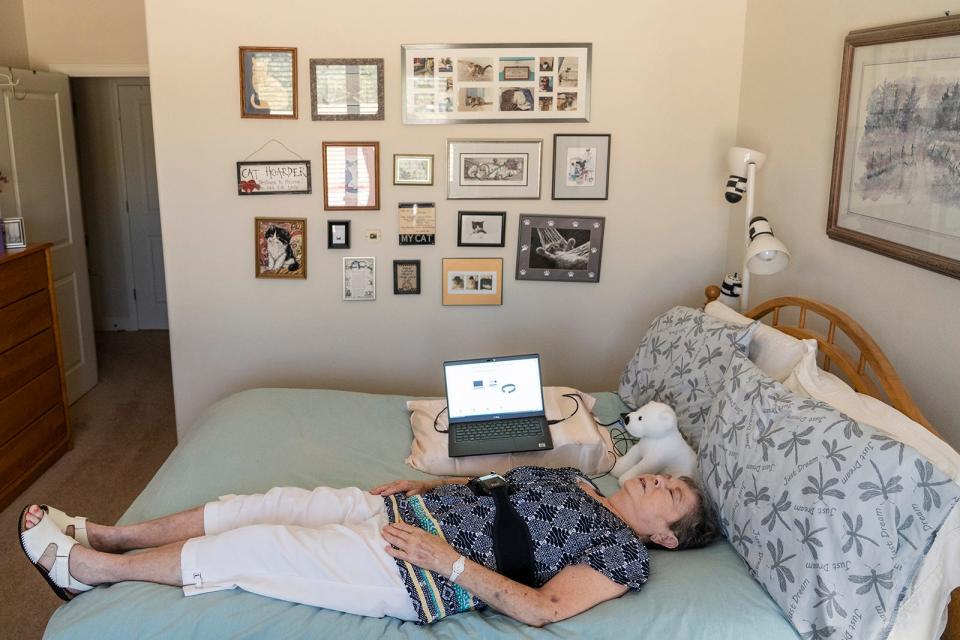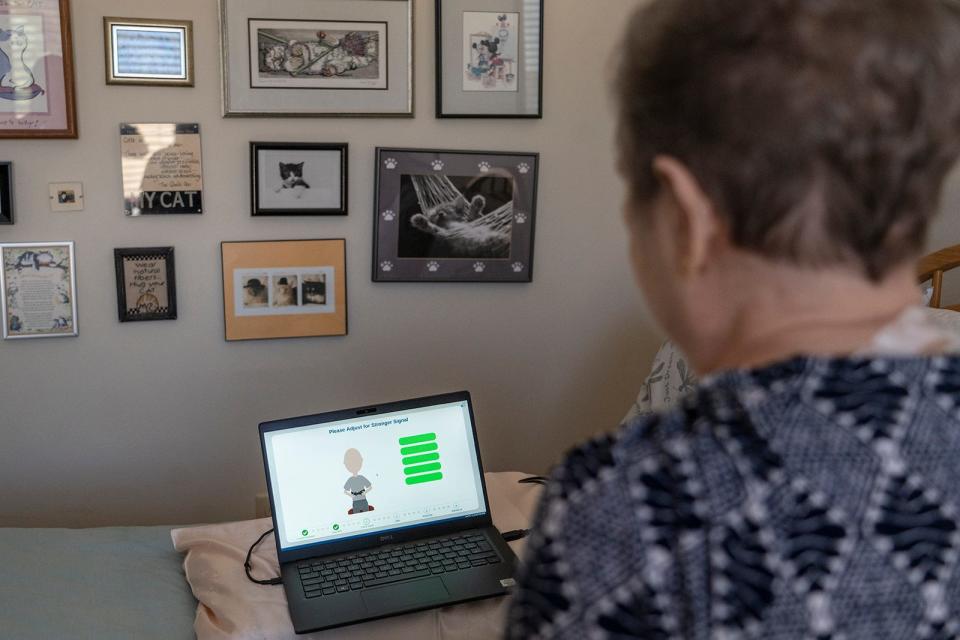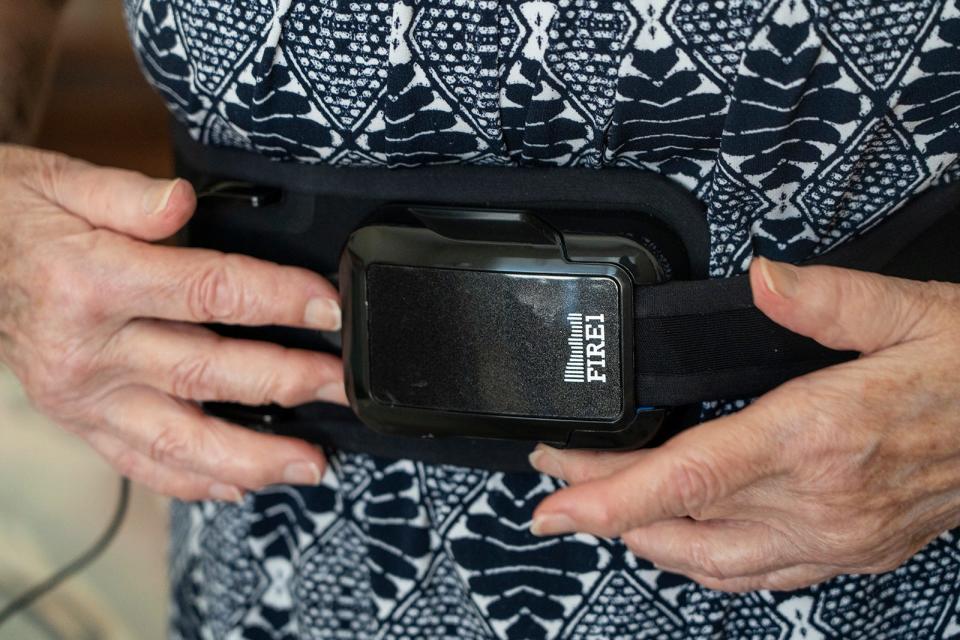Austin hospital is first in country to test new Fire1 heart failure monitor

Every morning, Donna Whitworth turns on two device monitors for her heart.
For the first device, she puts on a belt, which is hooked up to a laptop. When the belt is in the proper position, the monitor tells her to take a deep breath and then release it and then take another deep breath.
Then for a minute, she remains still resting on her bed and breathes normally as the belt connects to the tiny Fire1 device inside her inferior vena cava, the large vein that brings blood into the right atrium of the heart.
The Fire1 measures the area of the large vein and transmits that data through the belt to the laptop and to her doctors. That measurement gives information about her heart failure on the right side of her heart.
Whitworth, 75, is one of three people in Central Texas who have had a Fire1 device implanted at Heart Hospital of Austin. They are the first patients in the country to be part of an early feasibility study from the Dublin, Ireland-based company Fire1.
Previously, 29 Fire1 devices had been installed in patients in Asia and Europe, said Dr. Kunjan Bhatt, a heart failure specialist at Heart Hospital of Austin and director of research at Austin Heart.
Austin Heart has been placing internal heart monitors in patients since 2014 and has now placed about 240 sensors, Bhatt said. Fire1 reached out to Austin Heart last spring to see if it would want to test the device on its patients.

Providing more up-to-date information
Whitworth also sends her doctors data on the left side of her heart, through a CardioMEMS device, which measures the pressure in her pulmonary artery. For that device, which has FDA approval, Whitworth rests on a monitor pillow that then sends the data to her doctor.
She also weighs herself, takes her blood pressure and makes a log of those measurements.
With all her measurements done, she then begins her day, which includes social events at her retirement community, playing games on her iPad, and reading mysteries.
Whitworth is one of three people who received the Fire1 device on June 22, she is the only one who also has a CardioMEMS.
How a CardioMEMS works: 'Continual feedback': How a tiny device is helping keep tabs on some Austin-area heart patients

How does the Fire1 work?
The Fire1 is implanted via the femoral vein by doctors. The procedure can be done as an outpatient in the catheter lab with the patient sedated.
Once the Fire1 device is placed correctly, it opens to a metal cylinder that stays in the vein. Bhatt explains that struts hold it in place, but the device does not impede blood flow.
When the Fire1 device comes near the belt monitor each day, it measures the area of the large vein. If the area of the vein is bigger, the pressure is rising. If the vein is smaller, the pressure is falling. If the area decreases severely, it could mean that the patient is dehydrated.
"If it is so big that the blood vessel is massively enlarged, it could mean you are really full of fluid," Bhatt said, explaining it's a sign of heart failure.

The need for these devices
For years, Whitworth had cardiac issues, including swelling in her feet and ankles. By 2021, her bloodwork showed she was in heart failure.
Ultimately, her doctors found she had a leaking mitral valve. It was replaced, but Whitworth still had problems with congestive heart failure.
"I'll do great for a while, then it will get out of whack," she said.
A year ago, she received the CardioMEMS, which helped doctors control her left-sided heart failure.
Left-side heart failure is associated with shortness of breath, Bhatt said. Right-sided heart failure is associated with leg and feet swelling and abdominal swelling, he said.
Her doctors, though, couldn't really tell what was going on with her right-sided heart failure.
In April, Whitworth was hospitalized twice due to heart failure. She had high potassium levels and liver problems caused by the heart failure. "It felt horrible," Whitworth said. "... like a bad flu."
Now with the devices, doctors get constant information, often before Whitworth feels symptoms. With that data, Bhatt said, they can make medication adjustments earlier.
Bhatt expects to place several more Fire1s into patients as part of the study.
"It's exciting to see there's more tech coming in this area where patients don't feel well and they have a high fatality and high morbidity rate," Batt said. "We can participate in their care. We can all be proactive in helping the heart community, helping them stay out of the hospital."
Since she's had the Fire1 device, she's received one call from her doctors to say that she looked a little dehydrated and asked her to drink more water.
"Things have been pretty quiet," Bhatt said. "She's been stable."
"These (device) readings are designed to keep me out of the hospital," Whitworth said. "I'm for anything that will do that."
Heart health: Statesman Health Reporter gets Heart Saver CT scan to look at risk for heart attack
This article originally appeared on Austin American-Statesman: Heart Hospital of Austin first to test Fire1 heart failure monitor

